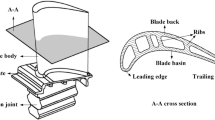Abstract
The preparation of the wax pattern is a key procedure in investment casting, playing an important role with the solidification of the metal on the final dimensional accuracy of the casting part. This study considered the injection procedure and the metal solidification as a whole and tried to discover the individual influence of both factors on the dimensional accuracy of the part. In this paper, a ring-to-ring wax pattern was scanned by a kind of 3D laser scanner after being injected, and its displacement field was used as the input of numerical analysis of the deformation happened in next step. Experimental measurement and numerical prediction were compared then, and the results indicated that predicted shrinkage based on the deformed wax pattern was close to the measured one with only 0.32 % difference on average, and the introduction of the injection procedure improves the numerical prediction by xxx%. The proposed method would benefit for the control of the shrinkage allowances of the casting part.
Similar content being viewed by others
References
Sabau AS, Viswanathan S (2003) Material properties for predicting wax pattern dimensions in investment casting. Mater Sci Eng A 362:125–134
Rezavand SAM, Behravesh AH (2007) An experimental investigation on dimensional stability of injected wax patterns of gas turbine blades. J Mater Process Technol 182:580–587
Pattnaik S, Karunakar DB, Jha PK (2013) Multi-characteristic optimization of wax patterns in the investment casting process using grey-fuzzy logic. Int J Adv Manuf Technol 67(5–8):1577–1587
Chen LG, Ling Y, Kang XH, Xia LJ, Li DZ (2008) Numerical simulation of stress and deformation for a duplex stainless steel impeller during casting and heat treatment processes. J Mater Sci Technol 24(3):364–368
Bonilla W, Masood SH, Iovenitti P (2001) An investigation of wax patterns for accuracy improvement in investment casting parts. Int J Adv Manuf Technol 18:348–356
Iqbal H, Sheikh AK, Yousef AA, Younas M (2012) Mold design optimization for sand casting of complex geometries using advance simulation tools. Mater Manuf Process 27:775–785
Gebelin JC, Jolly MR (2003) Modeling of the investment casting process. J Mater Process Technol 135:291–300
Song Y, Yan Y, Zhang R, Lu Q, Xu D (2002) Boundary model between casting and mould and its influence on the dimensional accuracy analysis of precision castings. Proc Inst Mech Eng B J Eng 216(8):1123–1134
Sabau AS, Porter WD (2008) Alloy shrinkage factors for the investment casting of 17-4PH stainless steel parts. Metall Trans B 39(2):317–330
Dong Y, Zhang DH, Bu K, Dou YW, Wang W (2011) Geometric parameter based optimization of the die profile for the investment casting of aerofoil-shaped turbine blades. Int J Adv Manuf Technol 57(9–12):1245–1258
Dong Y, Bu K, Zhang DH, Dou YW, Zhang DH (2011) Determination of wax pattern die profile for investment casting of turbine blades. Trans Nonferrous Metals Soc 21:378–387
Liu BC, Kang JW, Huang TY (2012) Stress analysis and deformation prediction of a heavy hydraulic turbine blade casting during casting and heat treatment. Mater Sci Technol 28(7):808–811
Peters FR, Voigt R, Ou SZ, Beckermann C (2007) Effect of mould expansion on pattern allowances in sand casting of steel. Int J Cast Met Res 20(5):275–287
Zhang DH, Jiang RS, Li JL, Wang WH, Bu K (2010) Cavity optimization for investment casting die of turbine blade based on reverse engineering. Int J Adv Manuf Technol 48:839–848
Moorwood G, Christodoulou P, Lahnam B, Byrnes D (2000) Contraction of investment cast H13 tool steel. Int J Cast Met 12:457–467
Wang DH, He B, Li F, Sun BD (2013) Numerical simulation of the wax injection process for investment casting. Mater Manuf Process 28:220–224
Guo Z, Saunders N, Miodownik AP, Schille JP (2005) Modelling of materials properties and behaviour critical to casting simulation. Mater Sci Eng A 413–414:465–469
Martínez S, Cuesta E, Barreiro J, Álvarez B (2010) Analysis of laser scanning and strategies for dimensional and geometrical control. Int J Adv Manuf Technol 46(5–8):621–629
Pattnaik S, Karunakar DB, Jha PK (2012) Developments in investment casting process—a review. J Mater Process Technol 212:2332–2348
Author information
Authors and Affiliations
Corresponding author
Rights and permissions
About this article
Cite this article
Wang, D., He, B., Liu, S. et al. Dimensional shrinkage prediction based on displacement field in investment casting. Int J Adv Manuf Technol 85, 201–208 (2016). https://doi.org/10.1007/s00170-015-7836-1
Received:
Accepted:
Published:
Issue Date:
DOI: https://doi.org/10.1007/s00170-015-7836-1



